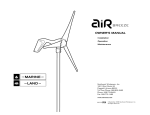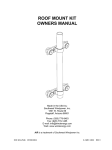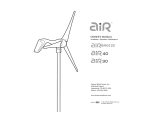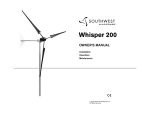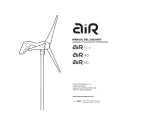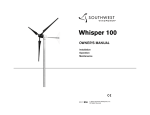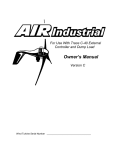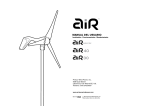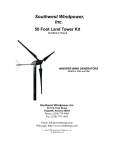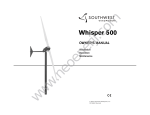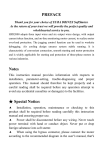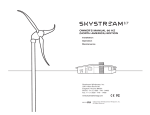Download Air Breeze Instruction Manual
Transcript
Owner’s Manual Installation • Operation • Maintenance Southwest Windpower, Inc. 1801 West Route 66 Flagstaff, Arizona 86001 Toll Free Phone: 866.805.9463 Phone: 928.779.9463 Fax: 928.779.1485 www.windenergy.com October 2011 Southwest Windpower, Inc. All Rights Reserved Southwest Windpower Congratulations on your purchase and welcome to our family! Dear AIR Breeze Owner, Thank you for your purchase of Air wind turbine. You have purchased the most advanced battery charging wind turbine in the world! We believe you will find it easy to install your AIR wind turbine and are confident you will experience years of dependable service from it. Before going any further, please complete and return the Warranty Registration Card or register on-line at wwww.windenergy.com, log-in and create an account to proceed with registration. The Lifetime warranty is effective only after the product has been registered. Note - Southwest Windpower does not sell or distribute your personal information to any third party. We understand and respect your privacy. If you have any questions or comments, we would like to hear from you. Please call during working hours (Monday-Friday – 8:00am to 5:00pm Arizona Standard Time). Our numbers are 928-779-9463, toll-free 866-805-9463. You can also access technical questions at www.windenergy.com/support/ technical-support/air-support. Again, welcome to our family and thank you for investing in the future of wind energy with a Southwest Windpower AIR wind turbine. Sincerely, Southwest Windpower Enter the serial and model numbers below AIR Breeze Installation Manual Document No. 3-CMLT-1333 Revision: A Serial Number __________________________________ Model Number __________________________________ AIR, AIR 403, AIR-X, AIR Wind Module are trademarks of Southwest Windpower © 2011 Southwest Windpower, Inc. AIR Breeze Owner’s Manual 3 One - Important Safety Instructions Read these instructions in their entirety before assembling, installing or operating your air breeze 1) SAVE THESE INSTRUCTIONS. This manual contains important instructions that must be followed during assembly, installation and maintenance. 2) Read, understand and respect all warnings. 3) Do not install AIR wind turbines on a windy day. 4) If unusual noise or operation is experienced, turn off machine and contact authorized service personnel. 5) During assembly and installation properly torque all fasteners. 6) Use only proper grounding techniques as established by the NEC. 7) Properly complete the Warranty Registration Card or register your product on-line. 8) AIR wind turbines must be installed in accordance with this manual and local and national building codes. Failure to comply with this manual and local codes may affect and possibly void your warranty. 9) Rotating blades are a serious mechanical hazard. Install AIR wind turbines so no one can come into contact with blades. 10) Observe wire size and fuse recommendations listed in the Wiring Section of this manual. 4 AIR Breeze Owner’s Manual In this manual you will see the following icons: IMPORTANT: Indicates instruction or advice that is critical for correct assembly or operation. Damage to equipment may result if not heeded. TIP: Indicates instruction or advice that may simplify or ease task or operation. WARNING: Indicates risk of severe injury or death or possible severe damage to equipment - proceed with caution and follow instructions. MARINE USE: Specific to Marine Use. Contents 1) important Safety Instructions_ _________________ 4 7) AIR wind turbine OPERATION_______________________ 23-25 TECHNICAL SPECIFICATIONS_________________________ 7 7-1 Operational Summary______________________________ 23 2) TURBINE ASSEMBLY_________________________________ 8 7-2 Operating Modes_ ________________________________ 23 3) SITING_ _____________________________________________ 9 7-3 Voltage Regulation________________________________ 24 4) TOWERS_____________________________________________ 10 7-3-1 Adjusting Regulation Voltage___________________ 24 4-1 Tower Options____________________________________ 10 7-3-2 Using an Alternate Charge Controller____________ 24-25 4-1-1 27 ft (8.3 m) Tower Kit________________________ 11 8) MAINTENANCE_______________________________________ 25 4-1-2 29 ft (8.8 m) Tower Kit________________________ 11 9) TROUBLE SHOOTING_________________________________ 26 4-1-3 45 ft (13.7 m) Tower Kit_______________________ 12 10) EXPLODED VIEWS & PARTS LIST_____________________ 27-28 4-1-4 Marine Tower Kit _ ___________________________ 12 11) Warranty_________________________________________ 29 5) WIRING OPTIONS_ ___________________________________ 13-14 5-1 Hybrid System Wiring______________________________ 15 5-2 Multiple AIR wind turbine Wiring_____________________ 16 5-3 Wire Size________________________________________ 17-18 5-4 Stop Switch______________________________________ 18 5-5 Fuses, Circuit Breakers, Ammeter____________________ 19 5-6 Batteries_ _______________________________________ 19 5-7 Turbine Grounding________________________________ 19-20 5-8 Tower Grounding__________________________________ 20 5-8-1 Electrodes Driven in Soil_ _____________________ 20 6) INSTALLATION_______________________________________ 21 6-1 Wire Connections_________________________________ 21 6-2 Mounting on Tower________________________________ 22 6-3 Final Connections_________________________________ 22 AIR Breeze Owner’s Manual 5 Notes __________________________________________________________________________________________________________________________________ __________________________________________________________________________________________________________________________________ __________________________________________________________________________________________________________________________________ __________________________________________________________________________________________________________________________________ __________________________________________________________________________________________________________________________________ __________________________________________________________________________________________________________________________________ __________________________________________________________________________________________________________________________________ __________________________________________________________________________________________________________________________________ __________________________________________________________________________________________________________________________________ __________________________________________________________________________________________________________________________________ __________________________________________________________________________________________________________________________________ __________________________________________________________________________________________________________________________________ __________________________________________________________________________________________________________________________________ __________________________________________________________________________________________________________________________________ __________________________________________________________________________________________________________________________________ __________________________________________________________________________________________________________________________________ __________________________________________________________________________________________________________________________________ __________________________________________________________________________________________________________________________________ __________________________________________________________________________________________________________________________________ __________________________________________________________________________________________________________________________________ 6 AIR Breeze Owner’s Manual AIR Breeze Technical Specifications Model AIR Breeze Weight 13 lb / 6 kg Rotor Diameter 46 in / 1.17 m Start Up Wind Speed 6 mph / 2.7 m/s Kilowatt Hours/month 38 kWh/month @ 12 mph / 5.4 m/s avg. wind speed Maximum Wind Speed 110 mph Rated Power 160 watts @ 28 mph / 12.5 m/s wind speed 24.5 in radius (61 cm) Operating Temperature Range AIR Breeze are certified under IEC requirements applying to the temperature range 14º F (-10º C) to 104º F (40º C) Voltage Regulation Set Point (factory setting) 12 Volt Systems 14.1 Volts 24 Volt Systems 28.2 Volts 48 Volt Systems 56.4 Volts Regulator Adjustment Range 12 Volt Systems 13.6 to 17.0 Volts (approximately) 24 Volt Systems 27.2 to 34.0 Volts (approximately) 48 Volt Systems 54.4 to 68.0 Volts (approximately) 26.6 in (67.5 cm) 46 in (1.15 cm) Recommended Fuse Size 12 Volt Systems 20 amp (slow blow) 24 Volt Systems 10 amp (slow blow) 48 Volt Systems 5 amp (slow blow) Tower Loads Shaft Thrust* 52 lb @ 100 mph wind speed (230 N @ 45 m/s) *Value does not include safety factor. SWWP recommends safety factor of 1.5. 22.5 in (56 cm) minimum safe pole length above obstructions 2.0 in (5 cm) AIR Breeze Owner’s Manual 7 Two - AIR Turbine Assembly Your AIR wind turbine is delivered partially assembled. Assembly requires mounting the blades on the blade hub, securing the hub to the turbine body and installing the nosecone on the blade hub. The necessary hex key (Allen) wrenches are furnished with your AIR wind turbine. Torque Specifications: Blade to hub screw, 1/4 - 20 x 1.375, socket head screw 72 in-lb (8.0 N·m) Hub to rotor nut, 5/8-18, 40 lb-ft (55 N·m) Yaw clamp bolts, M5-0.8 x 35 mm 48 in-lb (5.5 N·m) Start the assembly by mounting the blades (Item1) to the blade hub as shown in Fig. 1. Place a nylock nut (Item 4) in the hexagonal detent on the back of the blade hub while positioning the blade on the hub. The blades must be “tilted” into position on the hub and can only be installed in one orientation. If your AIR wind turbine is to be installed after the tower is erected, it is safer and easier to first install the turbine body on the tower and then install the hub/blade assembly. This will avoid attempting to mount the turbine while the blades are spinning – a dangerous condition. WARNING: Don’t attempt to mount the turbine while blades are spinning. Snap the nosecone into position over the outside edges of the blade hub. Make sure all three edges of the nosecone snap over the edge of the blade hub. After installation tug on the nosecone to make sure it is securely attached. 3 2 1 Place a washer (Item 2) on a 1/4 - 20 socket head screw (Item 3). Tighten the screw to 72 in-lb (8.0 N·m). Repeat for the remaining two blades. Nylock nuts may only be used one time; replace after each use. Important: Tef-Gel is a corrosion inhibitor and is especially important in marine applications. If your AIR wind turbine is to be installed on a “tilt-up” tower, mount the blade/hub assembly to the turbine now. Coat the alternator rotor shaft threads and blade hub bore with Tef-Gel and slide the hub onto the shaft. Start the 5/8-18 hub nut on shaft threads and “spin” the hub completely onto the turbine alternator shaft. Fully tighten the hub to 40 lb-ft (55 N·m) by inserting a 5/16 inch hex key wrench in the turbine alternator shaft and turning the shaft while turning the blades. 1- blades 2- washer 3- 1/4 - 20 socket head screw 4- nylock nut 4 Fig. 1 AIR wind turbine Blade Attachment Detail. 8 AIR Breeze Owner’s Manual Three - AIR Wind Turbine Siting Small changes in wind speed can have a dramatic effect on power production. The siting of your wind turbine should be carefully considered. Each installation is different and is often a compromise among tower height, distance from the battery bank, local zoning requirements and obstacles such as buildings and trees. In general the higher the tower, the greater the wind speed and ultimately power production. However, towers are expensive and can easily exceed the cost of the turbine. The minimum recommended tower height is 25 ft (7.6 m) on open ground or 20 ft (6 m) above nearby obstructions. (Fig. 2) Try to locate the wind turbine in the “cleanest” turbulent free air as possible. Turbulence will reduce the efficiency of the wind turbine and may accelerate wear on rotating components. Safety must be the primary concern when selecting the mounting location. Install AIR wind turbine so there is no possibility of accidental contact with rotating blades even if it requires installing the wind turbine in a less than ideal location. Safety has precedence over efficiency. WARNING: Install your AIR wind turbine so there is no possibility of accidental contact with rotating blades even if it requires installing the wind turbine in a less than ideal location. Prevailing wind 20 feet (6 m) Fig. 2 Optimal AIR Breeze location. AIR Breeze Owner’s Manual 9 Four - AIR Wind Turbine Towers The AIR wind turbine is designed to mount on tubing or pipe with a nominal 1.875 – 1.900 inch outside diameter. This dimension enables constructing a tower from a range of readily available materials including 1 1/2 inch Schedule 40 steel pipe and 2 inch SS-20 galvanized fence tubing (0.090 inch wall thickness). Under no circumstances should plastic pipe be used to construct a tower. 4-1 Tower Options Southwest Windpower offers a number of tower choices for your AIR wind turbine. The following section provides a summary of the available towers. User manuals for the towers and tower kits are available online and you are encouraged to review them in order to make the most informed tower selection. See Fig. 3. WARNING: Plastic pipe should NEVER be used to construct a tower. Important: User manuals for towers and tower kits are available online at www.windenergy.com. Southwest Windpower recommends reviewing them to make an appropriate tower selection for your AIR wind turbine. Fig. 3. Tower Options 27 ft (8.3 m) Tower 10 AIR Breeze Owner’s Manual 29 ft (8.8 m) Tower 45 ft (13.7 m) Tower 4-1-1 27 ft (8.3 m) Tower Kit (Southwest Windpower part number 1-TWA-10-01) 4-1-2 29 ft (8.8 m) EZ – Tower (Southwest Windpower part number 1-TWA-11-01) The 27 ft (8.3 m) Tower Kit includes a tower clamp/guy wire assembly and all necessary hardware and fasteners to erect a 27 ft tilt-up tower using Schedule 40 steel pipe or tubing with an outside diameter of 1.875 inch. See Fig. 4. The 29 ft (8.8 m) EZ Tower is a complete kit that includes all materials required to assemble a 29 ft guy wire tilt-up tower. Anchors, guy wire assemblies, galvanized steel tubing and all fasteners are included with the kit. See Fig. 5. Note: Anchors and pipe or tubing are not furnished with the kit so 27' AIR TOWER you have the flexibility to use the most appropriate components for the installation. 29'EZ TOWER KIT 4x 4x 4x x8 x16 x8 x4 x2 Fig. 4. 27 ft (8.3 m) Tower Kit Fig. 5. 29 ft (8.8 m) Tower Kit AIR Breeze Owner’s Manual 11 4-1-3 45 ft (13.7 m) Tower Kit (Southwest Windpower part number 1-TWA-10-02) 4-1-4 Marine Tower Kit (Southwest Windpower part number 1-TWA-20-02) The 45 ft (13.7 m) Tower Kit includes tower clamp/guy wire assemblies and all necessary hardware and fasteners to erect a 45 ft tilt-up tower using Schedule 40 steel pipe or tubing with an outside diameter of 1.875 inch. See Fig. 6. The Marine Tower Kit is specifically designed to aid mounting the turbine on a boat deck. Kit includes powdercoated aluminum mast and stays, vibration damping mounts and all necessary marine grade hardware to install the kit. See Fig. 7. Note: Anchors and pipe or tubing are not furnished with the kit so you have the flexibility to use the most appropriate components for the installation. 45' AIR TOWER 3x x2 8x 16x Fig. 6. 45 ft (13.7 m) Tower Kit Important: User manuals for towers and tower kits are available online at www.windenergy.com. Southwest Windpower recommends reviewing them to make an appropriate tower selection for your AIR wind turbine. 12 AIR Breeze Owner’s Manual Fig. 7. Marine Tower Kit Five - AIR Wind Turbine Wiring Options The recommended way to connect the turbine to your battery bank is to wire the turbine directly to its own set of battery posts. This will allow the turbine to operate independently. The AIR wind turbine’s internal regulator will monitor the battery and maintain the charge as necessary. Figs. 9 and 10 represent typical single turbine installations. Fig. 10 includes an up-tower junction box for UL (Underwriters Laboratory) compliance. Contact Southwest Windpower for more information about this configuration. AIR BREEZE Wind Turbine Generator TIP: Wire turbine directly to battery bank to its own set of battery posts. Tower User Power Center Junction Box Battery Disconnect Fuse or Breaker Amp Meter Tower Ground Stop Switch Turbine Positive Red Lead Turbine Ground Green Lead Chassis Ground Earth Ground Turbine Negative Black Lead Battery Bank Fig. 9. Single Turbine Installation Ground Rod AIR Breeze Owner’s Manual 13 Fig. 10 represents a system with an Up Tower Junction Box. The junction box may be installed close to the top of the tower to ease installing a Lightning Arrestor or it may be mounted close to the tower base and incorporate the stop switch. Typically installing the box will require drilling holes in the tower to install the box – be careful not to compromise the tower strength. Up-Tower Junction Box AIR BREEZE Wind Turbine Generator Lightning Arrestor Tower User Power Center Junction Box Battery Disconnect Fuse or Breaker Amp Meter Stop Switch Turbine Positive Red Lead Turbine Ground Green Lead Chassis Ground Earth Ground Turbine Negative Black Lead Battery Bank 14 AIR Breeze Owner’s Manual Earth Ground Fig. 10. Single Turbine Installation with Up-Tower Junction Box 5-1 Hybrid System Wiring PV Solar Array Fig. 11 represents a typical “hybrid” system with solar panels. Some charging sources (solar panels, fuel-powered generators, additional wind generators, etc.) connected to the same system may cause interference with the AIR wind turbine internal electronics and result in pre-regulation. The interference will not harm the turbine; it will just cause it to spin slowly as if “braked” or it may stop the turbine. If this occurs, test for possible interference by disconnecting the other charging sources to determine the possible cause. If possible wire the turbine and PV panels to their own set of battery posts. Amp Meter User Power Center Junction Box Amp Meter Tower Battery Fuse or Disconnect Breaker TIP: In this figure the AIR wind turbine internal regulator is used. A diversion type external regulator could also have been used. TIP: Voltage “pre-regulation” may be prevented by increasing the regulation set point. See section 7-3-2. AIR Wind Turbine Generator PV Charge Controller Battery Disconnect Fuse or Breaker Resistive Load Turbine Positive Red Lead Chassis Ground (Optional) Diversion Load Controller Tower Ground Stop Switch Turbine Negative Black Lead Turbine Ground Green Lead Earth Ground Battery Bank Ground Rod Fig. 11. Hybrid System with Solar Panels AIR Breeze Owner’s Manual 15 5-2 Multiple AIR wind turbine Wiring It is possible to wire multiple AIR wind turbines together. A typical multi-turbine system is depicted in Fig. 12. AIR Wind Turbine Generator There are two methods used to accomplish this task. AIR Wind Turbine Generator AIR Wind Turbine Generator Method One: Fuse or Breaker Battery Disconnect Fuse or Breaker Tower Ground Turbine Positive Red Lead Stop Switch Green Lead Turbine Ground Tower Turbine Negative Black Lead Fuse or Stop Switch Breaker Tower Ground Turbine Positive Red Lead Green Lead Turbine Ground Tower Turbine Negative Black Lead Wire each turbine to a “bus” and then run one set of wires from the bus to the battery. Each turbine’s internal regulator or an external diversion type regulator may be utilized. A “bus” system typically results in reduced wire costs. Tower Ground Turbine Positive Red Lead Method Two: Tower Turbine Negative Black Lead Each AIR wind turbine is treated separately. Each turbine will have its own wires, stop switch and fuse and will connect directly to the battery using the internal regulator to control charging. Green Lead Turbine Ground Stop Switch Amp Meter Battery Bank Fig. 12. Multiple Air wind turbine Wiring Ground Rod 16 AIR Breeze Owner’s Manual Fuse or Breaker Earth Ground 5-3 Wire Size All electrical systems lose energy due to resistance in conductors: the wires. We recommend these as the minimum wire sizes; for optimal performance use the largest wires that are practical and affordable. Local, state, and national electrical codes have precedence over these recommendations and must be followed to ensure the safety of your system. • Large wires have less resistance but can be considerably more costly. • Resistance losses will also increase with increasing current, therefore, if yours is a high wind site, it may be worthwhile to go with a larger size wire to take advantage of the greater power production potential of your site. Note: Wiring Resistance and Regulation Depending on your exact system configuration including other charging sources in your system, wiring resistance may affect the regulation set point of the turbine. Higher wiring resistance (smaller wires) will tend to lower the voltage at which the turbine enters regulation and stops charging. The recommended wiring sizes should provide little effect on the regulation set point, but all installations should be observed over time to ensure that the batteries are charged to the proper voltage. • Conversely, in low wind sites it may not be cost effective to increase the wire size since power production will be low. The following wiring sizes provide maximum annual energy losses of 5% or less for sites with a 12 mph average wind speed (assuming the standard Rayleigh distribution of wind speeds) which is sufficient for most sites. To determine the size wire, measure the distance from the batteries to your AIR wind turbine. Be sure to include height of the tower. Refer to the appropriate chart for your system voltage and number of turbines and select the wire size. TIP: Smaller wires will lower the voltage at which the AIR wind turbine enters regulation and stops charging. 12 Volt Systems, AWG / Metric Wire Size mm2 Number of Turbines: 0-30 ft (0-9 m) 30 ft-60 ft (9-18 m) 60 ft-90 ft (18-27 m) 90 ft-150 ft (27-46 m) 150 ft-190 ft (46-58 m) 190 ft-250 ft (58-76 m) 250 ft-310 ft (76-95 m) 310 ft-390 ft (95-119 m) 390 ft-500 ft (119-152 m) 1 8/10 mm2 6/16 mm2 4/24 mm2 2/35 mm2 1/50 mm2 0/50 mm2 00/10 mm2 000/90 mm2 000/90 mm2 2 6/16 mm2 4/25 mm2 1/50 mm2 00/70 mm2 000/90 mm2 0000/120 mm2 *** *** *** 3 4/25 mm 2/35 mm 0/50 mm 000/90 mm *** *** *** *** 2 2 2 2 0000/120 mm 2 *** If your system requires this length of wire, consider using parallel wires. 24 Volt Systems, AWG / Metric Wire Size mm2 Number of Turbines: 0-30 ft (0-9 m) 30 ft-60 ft (9-18 m) 60 ft-90 ft (18-27 m) 90 ft-150 ft (27-46 m) 150 ft-190 ft (46-58 m) 190 ft-250 ft (58-76 m) 250 ft-310 ft (76-95 m) 310 ft-390 ft (95-119 m) 390 ft-500 ft (119-152 m) 1 14/2.5 mm2 12/4 mm2 10/6 mm2 8/10 mm2 6/16 mm2 4/50 mm2 4/10 mm2 4/90 mm2 2/90 mm2 2 12/4 mm2 8/10 mm2 6/16 mm2 4/25 mm2 4/25 mm2 2/35 mm2 2/35 mm2 1/50 mm2 0/50 mm2 3 10/6 mm2 8/10 mm2 6/16 mm2 4/25 mm2 2/35 mm2 2/35 mm2 1/50 mm2 0/50 mm2 00/10 mm2 AIR Breeze Owner’s Manual 17 48 Volt Systems, AWG / Metric Wire Size mm2 Number of Turbines: 0-90 ft (0-27 m) 90 -250 ft (27-76 m) 250 -310 ft (76-95 m) 310 -500 ft (95-152 m) 1 14/2.5 mm 12/4 mm 2 10/6 mm 8/10 mm2 2 12/4 mm2 8/10 mm2 6/16 mm2 4/25 mm2 3 10/6 mm2 8/10 mm2 6/16 mm2 4/25 mm2 2 2 5-4 Stop Switch (Southwest Windpower part number 2-ARAC-101) Stop Switch Assembly Southwest Windpower recommends the use of a stop switch to provide a convenient method for shutting down your AIR wind turbine. A switch is supplied with each AIR Breeze wind turbine as standard equipment. 1. Use either the rubber sleeved nut or the knurled nut but do not use both. Install and wire the switch as shown in Fig. 13. A “break then make” switch must be used. The switch first disconnects the battery and then shorts the turbine output wires together causing the turbine to stop spinning (in high winds the blades may spin slowly). Shorting the turbine does not cause any damage or additional wear on the unit. The stop switch model offered by Southwest Windpower is sufficient for most systems, but it should not be used in applications where a code compliant switch is necessary. 3. The backing jam nut may be adjusted to allow the switch to mount flush with the panel. 4. No larger then 8 gauge wire should be connected directly to switch. Short lengths (inches) of 8 gauge wire may be used as a transition to larger gauge wire. Eye connectors are recommended. 5. Large gauge wire should be supported. The switch terminals are not to bear the weight of the wire. 1 TURBINE BLACK WIRE 18 AIR Breeze Owner’s Manual 3 m FUSE MARINE USE: A Stop Switch is standard equipment with the AIR Breeze. 2 RED WIRE 12 m NOTE: The center post must be positive from the turbine. Outside posts can be swapped as either battery positive or battery/ turbine negative. 2. Drill 12 mm (0.4725 in) hole in panel. STOP SWITCH 4 Fig. 14. Stop Switch Assembly BATTERY Fig. 13. Stop Switch Wiring 5-5 Fuses, Circuit Breakers and Ammeter 5-6 Batteries AIR wind turbine’s are capable of producing high amperages. As with all electrical installations, you must protect each of your turbines with a fuse or circuit breaker. Wire your AIR wind turbine with an appropriate size “slowblow” fuse or circuit breaker between it and the batteries. Refer to installation figures at the start of Section 5. If a stop switch is used, the fuse or circuit breaker should be placed between the switch and the batteries. There are many battery choices available – flooded lead acid, absorbed glass mat (AGM), gel cell and NiCad. The type of battery utilized will depend largely on the battery bank location and cost. For battery installations where fumes can be safely ventilated and the potential for acid leakage accommodated, the flooded lead acid battery is typically the most economical choice. Recommended Sizes for Circuit Breakers or Slow-Blow Fuses Minimum recommended battery bank size: • 12-volt model: 20 amps DC, part number 3-ELOT-1147-03 • 24-volt model: 10 amps DC, part number 3-ELOT-1147-02 • 48-volt model: 5 amps DC, part number 3-ELOT-1147-01 Circuit Breakers are available from Southwest Windpower. Part numbers are listed above. • 12-volt systems – 400 Amp-hours • 24-volt systems – 200 Amp-hours • 48-volt systems – 200 Amp-hours There are several informative web sites with battery information including: • www.batterycouncil.org • www.windsun.com/Batteries/Battery_FAQ.htm Important: Never use “automotive” batteries or any battery other than a “deep-cycle” battery. 5-7 Turbine Grounding Proper grounding of the AIR wind turbine provides protection to individuals and equipment by eliminating the possibility of dangerous voltage potentials. Fig. 15 Circuit Breaker Fig. 16 Ammeter (Amp Meter) PN 2-ARAC-102 While not necessary, an ammeter (sometimes called an Amp Meter) is an excellent addition to any system. The Amp Meter allows you to monitor the current output of your turbine. Place it in between your turbine and the battery on the positive lead. It will give you instantaneous readings of output in amps. There are two aspects to grounding any electrical system – grounding one of the conductors of the electrical system and grounding all metal structures in the system that may have a voltage potential caused by an electrical failure. In a typical AIR wind turbine installation grounding one of the conductors is accomplished by connecting the AIR wind turbine negative (black) conductor to an “earth” ground close to the battery bank. Installation and connection to grounding rods is described in the following section on Tower Grounding. Grounding the metal structures in the system – typically this includes the tower and turbine – is accomplished by connecting the structures together using conductors of the same size as the positive and negative conductors and then routing a conductor to an earth ground. AIR Breeze Owner’s Manual 19 The following section (5-8) describes grounding the tower in detail. To ground the AIR wind turbine body, connect the AIR wind turbine ground (green) conductor to the tower ground rod. Alternately the ground (green) conductor may be connected to the negative (black) conductor in which case it will be grounded through the battery bank ground rod. Refer to figures 9 through 12. Note that all system grounds should be connected using conductors of the same size as the positive and negative wires. If you choose to not set up an earth ground system (not required for systems under 50 volts), the AIR wind turbine green and black conductors MUST be connected to each other or severe damage to AIR wind turbine may result and void your warranty. Southwest Windpower strongly recommends that boat installations be grounded according to American Boat and Yacht Council recommendations. There are special grounding requirements for boats, in particular boats that connect to shore AC power, that MUST be observed or a serious shock hazard may result. Contact the American Boat and Yacht Council at 410.990.4460 or visit their website at www.abyc.com. 5-8 Tower Grounding (Fig. 16) Every wind turbine and turbine tower should be grounded at the tower base even though the system may be grounded at the battery bank or service panel by means of the yaw ground lead. Grounding the tower at its base may prevent shocks to persons touching the tower due to lightning or electrical faults. The following sections are provided as a guide to properly grounding the tower and should not be considered completely comprehensive. You are encouraged to reference the National Electrical Code (NEC) and local building and zoning regulations for complete requirements. Relevant sections of the National Electrical Code are referenced. Tower grounding may be accomplished in several ways; the most common method is a copper clad steel electrode(s) driven into the soil and connected to the tower using a wire conductor. 20 AIR Breeze Owner’s Manual 5-8-1 Electrodes Driven in Soil Electrodes should be a minimum of 8 ft (2.5 m) in length and free of nonconductive coatings such as paint. Hollow electrodes of pipe or conduit should not be smaller than trade size 3/4 (metric designator 21) and must be galvanized or otherwise protected from corrosion. Solid rod electrodes must be at least 5/8 inch (16 mm) diameter. Stainless steel rods less than 5/8 inch diameter, nonferrous rods or their equivalent less than 1/2 inch diameter shall be “listed” by an organization having jurisdiction in the area. For example: UL in the USA and CSA in Canada. Electrodes shall be installed such that 8 ft (2.5 m) is in contact with the soil. They should be driven into undisturbed soil within 1 ft of the tower foundation. Electrodes should be driven to a depth of 8 ft (2.5 m) except where rock is encountered; then the electrode may be driven at an angle not to exceed 45 degrees from vertical. Some local authorities permit burial of the electrode in a trench that is a minimum of 30 inch (76 cm) deep. The upper end of the electrode and its connection to the grounding conductor should be below grade or if above ground, must be protected from damage. Bonding the grounding conductor to the electrode and to the tower may be accomplished by exothermic weld or by a “listed” mechanical connector. Solder connections are not permitted. Most local authorities require a minimum grounding conductor size of 6 AWG for copper and 4 AWG for aluminum (if aluminum is permitted). The grounding conductor may be buried directly or contained in conduit; in either case it is important that it have no sharp bends to keep its inductance low. The accompanying figure depicts a typical tower grounding technique and the following sections of the NEC are listed for reference. Six - AIR wind turbine Installation The following are general guidelines for the installation of AIR wind turbine. Because each wind turbine installation is unique, specific step-by-step installation instructions cannot be provided. However, before attempting final installation the following basic steps should be completed: • Completely review AIR Breeze Owner’s Manual. • Assemble AIR wind turbine. Blades and hub may be left off depending on tower type – see Section 2.0 Turbine Assembly. • Select tower and tower site and install tower. See Sections 3.0 and 4.0. • Determine wire size. See Section 5.3 • Design system including batteries, switches, circuit breakers, and ammeter. Draw wiring diagram. • Obtain required components – batteries, switches, circuit breakers, wire, tools, etc. Once these steps are completed, final assembly is fairly simple and consists primarily of making good electrical connections according to the wiring diagram and mounting your AIR wind turbine on the tower. 6-1 Wire Connections to AIR wind turbine WARNING: Do not connect wires to batteries until all electrical connections are completed. Fig. 16 Tower Grounding 2005 NEC Section Article 250.52, item 5 Article 250.53, item A Article 250.53, item G Article 250.64 Article 250.66, item A Article 270.70 Topic Tower Grounding Tower Grounding Grounding Electrode Installation Grounding Conductor Routing and Placement Grounding Conductor Size Bonding of Grounding Conductor Connect wire leads from AIR wind turbine to wires to be run down the tower using “split bolt” or solder connectors. Follow good practice and use color coded wires – red for battery positive, black for battery negative, and green for earth ground. Wires must be sized based on turbine to battery bank distance. Refer to Section 5. Insulate connections with heat shrink tubing or good quality electrical tape. Leave sufficient service loop in the wires to accommodate removal of the turbine from the tower. AIR Breeze Owner’s Manual 21 Follow system wiring diagram and run wires to disconnect switch, fuse or circuit breaker and ammeter. If a stop switch is utilized (highly recommended) turn switch to OFF until all connections are completed. 6-3 Final Connections Before making final connections to the batteries, make sure circuit breakers and stop switch are in the OFF position. Attach wires to battery; red to positive battery terminal and black to negative battery terminal. 6-2 Mounting on Tower After wires are connected to the AIR wind turbine, route the wires down the tower and slide the turbine yaw over tower top. After the yaw is completely lowered onto tower top, lift the yaw approximately 1/8 inch (3 mm) to 1/4 inch (6 mm) so that the only contact between the yaw and tower top is through the rubber isolation pad. This will reduce noise and vibration transmission to the tower. Once the yaw is positioned on the tower, secure the yaw clamp screws using the supplied 5/32 inch hex key wrench. Torque to 48 in – lbs (5.5 N·m). If blade/hub assembly is not already installed on turbine, it may be installed now. Position the 5/8-18 nut in the hexagonal detent at the center of the hub. Coat the shaft threads and blade hub bore with Tef-Gel and “spin” the hub completely onto the turbine alternator shaft. Fully tighten hub to 50 lb-ft by inserting a 5/16 inch hex key wrench in the turbine alternator shaft and attempting to turn the shaft while holding the blades. Snap the nosecone into position over the outside edges of the blade hub. Make sure all three edges of the nosecone snap over the edge of the blade hub. After installation tug on the nosecone to make sure it is securely attached. Important: Tef-Gel is a corrosion inhibitor and is especially important in marine applications. 22 AIR Breeze Owner’s Manual WARNING: If the battery connections are reversed, the AIR wind turbine’s electronics will be damaged. The polarity of the AIR wind turbine’s wires may be checked by connecting a voltmeter to the wires and spinning the rotor by hand. Complete battery connections and switch on circuit breakers and stop switch. When power is first switched on, the wind turbine LED will come on for two seconds, go off for two second and come on for four seconds. This indicates the internal controller is functioning properly. If there is available wind and you AIR wind turbine starts charging the batteries, the LED remains illuminated. The installation is now complete. Seven - AIR wind turbine Operation 7-1 Operational Summary Wind turbines operate by capturing the kinetic energy of moving air: the wind. They convert it to rotational motion to turn an alternator that produces electrical power. The electrical power must be regulated to a voltage to charge the system batteries, and there must be a system to prevent overcharging the batteries and resume charging as the battery voltage drops. A means to protect the wind turbine from extreme wind damage must also be provided. The AIR wind turbine accomplishes all these goals by incorporating a three-phase brushless permanent magnet alternator and microprocessor controlled electronics to optimize its power production capability. The microprocessor continuously adjusts the loading of the alternator to keep the turbine operating efficiently in most wind regimes. The result: • high power production; • high blade efficiency; and • lower blade noise. 7-2 Operating Modes Charging: When the AIR wind turbine is connected to the batteries with the voltage below the set point the blades spin in response to the wind. The blades continue to spin unless the batteries are fully charged or the wind is excessively high. The AIR wind turbine features dynamic software allowing it to continue to generate energy up to 50 mph (22 m/s); however, under these conditions the turbine blades will drop in speed to control heat build-up. Note that the AIR wind turbine requires a minimum battery bank voltage (approximately 10.5 volts on a 12-volt system) or the controller will behave as if an open circuit condition exists. Refer to Open Circuit/Free Spinning section. When charging the batteries, the AIR wind turbine LED will be continuously illuminated. Regulation: As the AIR wind turbine produces power and the battery voltage rises to the regulation set point voltage, the AIR wind turbine will go into “regulation.” At that point it stops producing power and the blade rpm will lower dramatically (almost stopping). The AIR wind turbine will remain in regulation until the battery voltage drops slightly below the regulation set point – this is often referred to as the cut-in voltage. When the cutin voltage is reached, the blades will resume spinning in response to the available wind. Regulation mode is indicated by the AIR wind turbine LED blinking at a rate of approximately once a second. Over Speed Protection: In gusty or continually high winds, over 50 mph (22 m/s), the AIR wind turbine will enter a protection mode where the blades come to a near stop. The turbine keeps the blades stopped for 30 seconds and then allows the blades to begin spinning. If the AIR wind turbine senses high or gusty wind speeds are still present, it will repeat the cycle until the wind speeds drop below 50 mph (22 m/s). Over speed protection is stressful on the AIR wind turbine. Southwest Windpower recommends taking measures to protect your wind turbine in excessively high wind situations. The AIR wind turbine’s LED will blink quickly – approximately 10 times per second when in over speed protection. Braking Mode: The AIR wind turbine may be placed in braking mode by directly shorting the turbine positive and negative wires together or by the use of a stop switch. The stop switch first disconnects the turbine from the battery and then shorts the positive and negative wires. In very strong winds the blades may rotate slowly even with the switch activated. No Load Operation /Open Circuit /Free Spinning: The AIR wind turbine will spin freely if disconnected from an electrical load. This results in a cycle of rapid blade speed followed by rapid braking – this mode of operation may accelerate wear of the turbine and is also non-productive. To turn the AIR wind turbine off for short periods of time Southwest Windpower recommends using a properly installed switch. If your AIR wind turbine will be shut down for an extended period of time Southwest Windpower recommends lowering the turbine completely or securing the blades to prevent rotation. AIR Breeze Owner’s Manual 23 7-3 Voltage Regulation The AIR wind turbine continually monitors the battery voltage and compares it to the voltage regulation set point. Refer to specifications for voltage regulation set points. The voltage regulation set points are factory set to the values listed in the specifications. These values may be adjusted to suit individual applications. When the voltage regulation set point is achieved, The AIR wind turbine enters regulation mode – effectively switching off and waiting for the battery voltage to drop to the cut-in voltage. The cut-in voltage is slightly lower than the voltage regulation set point. The difference between the two values is referred to as “hysteresis” and is purposely done so the turbine does not bounce in and out of a single regulation set point. Refer to specifications for specific voltage cut-in values. System Voltage Voltage Regulation Set-Point Adjustment Range* Voltage Change due to 1/8 Turn of Potentiometer** 12 Volt 13.6 – 17.0 Volts 0.56 Volts 24 Volt 27.2 – 34.0 Volts 1.12 Volts 48 Volt 54.4 – 68.0 Volts 2.24 Volts * Adjustment ranges are approximate; actual ranges may be greater. CAUTION: Increasing the voltage regulation set point above the initial factory setting will NOT increase the power output of the AIR wind turbine. This adjustment changes the point at which the turbine stops charging the batteries. By setting the voltage too high you may increase the probability of overcharging and damaging the batteries. 7-3-1 Adjusting Regulation Voltage The voltage regulation set point is adjustable using the potentiometer on the side of the AIR wind turbine body. Please read the accompanying caution before attempting to adjust the voltage regulation set point. ** Turn clockwise to increase voltage, counter-clockwise to decrease voltage. The most accurate method of setting the regulation voltage is to disconnect the turbine from the batteries and use an adjustable voltage source and multi-meter to apply the desired voltage across the positive and negative turbine leads. With the target voltage applied, turn the potentiometer fully clockwise, and then slowly turn the potentiometer counter-clockwise until the LED just illuminates. The regulation set point will then be set to the voltage applied across the turbine leads. There are some conditions under which the AIR wind turbine’s internal regulator is not appropriate as the primary regulator. These conditions include: Alternatively, the regulation set point voltage may be adjusted using a trial and error method. Use the accompanying chart as a guide to increase or decrease the voltage regulation set point. Monitor the battery voltage over a period of time and make small adjustments until the regulation set point voltage is at the desired level. 7-3-2 Using an Alternate Charge Controller • Systems where battery temperature varies widely Battery charge efficiency varies in extreme temperatures. If these conditions exist, an external regulator with a temperature compensation sensor should be used to optimize the charge rate. There are several regulators available that adjust the charge rate based on ambient battery temperature. • Batteries that are extremely sensitive to charge voltage Follow the recommendations of the battery manufacturer. For most battery systems the AIR wind turbine internal voltage regulator is completely adequate. • Multiple turbines with a bus system Multiple turbine installations will typically function best using a single voltage regulator close to the battery bank. This is particularly true if the wire lengths connecting each turbine to the bus vary by distance or wire gauge. 24 AIR Breeze Owner’s Manual The AIR wind turbine’s internal voltage regulator cannot be completely turned off; however, by setting the voltage regulation set-point to its highest value (potentiometer turned completely clockwise), the AIR wind turbine’s internal regulator may be virtually eliminated from the battery charging system. If a charge controller other than the AIR wind turbine internal controller is utilized, it must be a diversion style regulator. A diversion style regulator charges the batteries, and as the batteries become charged, the excess power is diverted to a resistive load. This technique allows for the capture of full turbine power even after the batteries are charged. Do not use a pulse width modulated (PWM) or shunt style controller; the AIR wind turbine is not designed to work with these types of controllers. Additionally, most controllers designed to work with solar panels are not suitable for use with the AIR wind turbine. These controllers “disconnect” the solar panels – or in this case the AIR wind turbine - from the battery bank when the batteries are charged, allowing the AIR wind turbine to spin free, which is not recommended. CAUTION: Do not use a pulse width modulated (PWM) or shunt style controller; the AIR wind turbine is not designed to work with these types of controllers. Additionally, most controllers designed to work with solar panels are not suitable for use with the AIR wind turbine. These controllers “disconnect” the solar panels – or in this case the AIR wind turbine - from the battery bank when the batteries are charged, allowing the AIR wind turbine to spin free, which is not recommended. Eight - AIR Wind Turbine Maintenance Although your AIR wind turbine has been designed to run for long periods of time with minimal maintenance, a device containing moving parts must be maintained from time to time in order to ensure maximum performance and reliability. As part of complying with the conditions of the Limited Lifetime Warranty, please adhere to the below. CAUTION: Never approach the turbine during operation. After one month and every six months thereafter: • • • • • • Check blades for chips or nicks. Replace blades if damaged. Do not operate the turbine with chipped or unbalanced blades. This will cause severe wear, damage and possible failure. Operating the wind turbine with unbalanced blades may void your warranty. Do not install individual blades as they are balanced as a set. Check blade bolts and hub nut for proper tightness. Refer to page 7 for proper specifications Check nosecone for any cracks and proper fit Wash off any built-up dirt or debris from the blades. This will ensure optimal performance. Check all electrical connections to make sure they are tight and free from corrosion. Check to see that your tower is plumb. A leaning tower will decrease energy production. Every five years: • Replace the blades regardless of their condition. While UV inhibitors are built into the material, the sun will eventually break down and erode the composite material. A new set of blades will enhance safety and improve performance. Every seven years: • • Replace the circuit board. Some components on the Circuit Board require periodic replacement due to stress from temperature and voltage fluctuations seen under normal operating conditions. While in the process of changing the circuit board, SWWP recommends checking the condition of the brushes and slip rings. With the turbine open and the yaw shaft removed, observe the brushes and slip rings for grooving or other signs of wear. AIR Breeze Owner’s Manual 25 Nine - AIR Wind Turbine Trouble Shooting Three quick bench tests can verify if your AIR wind turbine is working correctly. Test 1 does not require any equipment. For tests 2 and 3 you will need a battery bank and a power drill. TEST 1 1) Remove the blade/hub assembly from the turbine and place in a safe location. Replace the rotor hub nut on the rotor shaft. 2) Attempt to quickly spin the rotor shaft with your fingers while connecting and disconnecting the red and black wires (turbine must not be connected to batteries). A second person may be helpful to perform this test. 3) With the red and black wires connected to each other, the shaft should be more difficult to turn. Replace the rotor hub nut on the rotor shaft. With the yaw wires disconnected it should spin freely. Spinning the shaft quickly makes difference easier to detect. If these conditions do not exist, you should contact your turbine dealer or Southwest Windpower. TEST 2 1) Remove blade/hub assembly from turbine and place in a safe location. 2) Connect the turbine power wires to the appropriate terminals on your battery: RED= Positive, BLACK = Negative. 3) Each time the AIR wind turbine is connected to a battery, the LED will come on for two seconds, go off for two seconds and come back on for four seconds to indicate that the controller is running properly. You may need to wait 10 seconds between iterations of this test in order to let the microprocessor reset. Turbine is in Brake Mode while initializing the controller. If the LED does not blink when the AIR wind turbine is connected to a battery, you should contact your turbine dealer or Southwest Windpower. 26 AIR Breeze Owner’s Manual TEST 3 1) With the AIR wind turbine connected to your battery bank, use an electric drill to spin the rotor shaft while observing the LED. A short length cut from the 5/16 inch hex key wrench can serve as a drive if necessary. 2) Below 400 RPM, the rotor should spin freely and the LED should remain off. 3) At 420 RPM and above, the AIR wind turbine should be charging the battery. There should be resistance on the rotor shaft and the LED should turn on. If the shaft is cogging (difficult to rotate), contact your turbine dealer or Southwest Windpower. Be sure your battery voltage is not high enough to activate the regulation mode during this test. 22 AIR BREEZE Ten - AIR wind turbine Exploded Views & Parts List 21 20 19 23 12 6 3X 11 24 2X 13 14 18 2X 25 10 5 17 26 16 15 2 9 8 7 4 1 3 3X 3X 3X 3X AIR Breeze Owner’s Manual 27 ITEM NO. 1 2 3 4 5 6 7 8 9 10 11 12 13 14 15 16 17 18 19 20 21 22 23 24 25 26 DESCRIPTION NOSE CONE - WHITE JAM NUT 5/8-18 - SS SCREW - SOCKET HEAD - 1/4-20 X 1-3/8 - SS WASHER - FLAT -1/4"- SS MACHINED - HUB - AIR - ANODIZED BLADE - BLACK NUT - NYLOCK - SAE - SS - 1/4"-20 SCREW - SOCKET HEAD - 10-24 X 1-1/2" MACHINED - FACE - AIR - PAINT - WHITE SNAP RING - 44MM INTERNAL BEARING - 6203-RLBZD - SEALED/SHIELDED WASHER - WAVE SPRING SPACER - BEARING BEARING - 6203-ZZ - SHIELDED ISOLATOR - STATOR STATOR - 16 AWG 17 TURNS STATOR - 18 AWG 34 TURNS STATOR - 21 AWG 60 TURNS ROTOR - HP SCREW - TAPTITE - 8/32 X 1" CIRCUIT & RECTIFIER ASSEMBLY - 12V CIRCUIT & RECTIFIER ASSEMBLY - 24V CIRCUIT & RECTIFIER ASSEMBLY - 48V WIRE HARNESS - POTENTIOMETER O-RING MACHINED - BODY - AIR - WHITE - PAINT BEARING - 6007 2RS SNAP RING - INTERNAL - 69MM - ZINC SNAP RING - 32MM STAINLESS STEEL YAW ASSEMBLY - PAINT - WHITE 28 AIR Breeze Owner’s Manual PART NUMBER 3-CMBP-2015-02 3-HDNT-912 3-HDBT-1024-007 3-HDWA-919 3-CMBP-2016-02 3-CMBP-2017-03 3-HDNT-102-10 3-HDBT-1000-577 3-CMBP-1003-01 3-CAOT-1005 3-CABR-1002 3-CAOT-1012 3-CAOT-1010 3-CABR-1001 3-CMBP-1341 3-CMBP-1019-02 3-CMBP-1019-03 3-CMBP-1019-05 3-CMBP-1313 3-HDBT-9000 3-CMBP-1021-12 3-CMBP-1021-24 3-CMBP-1021-48 3-CMBP-1033-02 3-CAOT-1002 3-CMBP-1000-04 3-CABR-1000 3-CAOT-1067 3-CAOT-1219 3-CMBP-1004-04 QTY. 1 1 3 3 1 3 3 3 1 1 1 2 1 1 1 1 1 2 1 1 1 1 1 1 1 1 11) AIR Breeze Wind Turbine Limited Lifetime Warranty What is Covered Southwest Windpower, Inc. (“Southwest Windpower”) warrants the AIR Breeze Wind Turbine against defects in factory-supplied materials and/or factory workmanship under normal authorized use consistent with the Wind Turbine’s Owner’s Manual, except for the limitations set forth in this Limited Warranty. How to Register a Claim Against Warranty If a defect arises with regard to any Wind Turbine part and a valid claim is received within the Warranty Period, Customer’s sole and exclusive remedy and the entire liability of Southwest Windpower, its dealers, suppliers and affiliates under this Limited Warranty is, at Southwest Windpower’s sole option, either (i) to repair free of charge the defective part, or (ii) exchange free of charge the defective part with a new or remanufactured part or wind turbine that is new or equivalent to new in performance and reliability and is at least functionally equivalent to the original wind turbine part. Repaired or exchanged wind turbine parts will be warranted for the remainder of the Warranty Period. If you experience any problem with your AIR Breeze Wind Turbine, please contact an authorized service dealer or Southwest Windpower directly. Retain all information and documents until the problem is resolved. Your authorized service dealer can provide you with a solution and start the claims process. You MUST demonstrate ownership with a copy of the original receipt that you are the primary owner of the wind turbine. Warranty claims notification must include a description of the defect, the serial number of the Wind Turbine at issue, and the original purchase date in addition to the name, address, and telephone number of the party requesting warranty service under this Limited Warranty. After Southwest Windpower is notified, Southwest Windpower representatives will make all reasonable efforts via phone and email to ascertain the nature of the problem to determine whether any part is defective for purposes of coverage under this Limited Warranty. Other than normal communication carrier charges, there is no charge for such diagnosis. Any repair or replacement will be provided only after Southwest Windpower’s diagnosis and its agreement to the defective condition. Certain diagnostic checks may be required to be performed by the end-user or designee at Southwest Windpower representatives’ request. All claims for defect shall be deemed waived unless made in writing and delivered to your Wind Turbine during the Warranty Period and not later than thirty (30) days after discovery of the defect. If Southwest Windpower representatives determine that the Wind Turbine requires service and that Customer’s service request constitutes a valid claim under this Warranty, Southwest Windpower will provide warranty service, at Southwest Windpower’s sole option, either (i) through an authorized dealer, with service to be performed at the servicer’s location; (ii) by sending replacement Wind Turbine or parts to the Customer. or (iii) by providing the Customer with a Return Authorization (“RA”) number to authorize the Customer to ship the defective Wind Turbine or Wind Turbine parts to Southwest Windpower for service. Any Wind Turbine part(s) requiring warranty repair shall be transported at the expense and risk of the party requiring warranty service, including but not limited to proper packaging of the part(s). Southwest Windpower will return to sender any Wind Turbine and/or part(s) that do not have a valid RA number. Southwest Windpower will use all reasonable efforts repair/replace the defective Wind Turbine and/or part(s). Repaired or replaced wind turbines and replacement parts will be delivered to the Customer at Southwest Windpower’s expense. If a warranty claim is invalid for any reason, Customer may be charged at Southwest Windpower’s and/or the authorized service dealer’s then-current rate for repair services performed. In such event, the Customer will be informed of the repair charges for prior approval, and, upon approval, will be charged for the approved repairs and return freight. If the Customer refuses to approve repair charges, return freight charges may apply. When a Wind Turbine part is replaced for a new or remanufactured part, such new or remanufactured part becomes Customer’s property and the replaced part becomes Southwest Windpower’s property. Customer property remaining at Southwest Windpower’s repair facilities for more than thirty (90) days without required Customer approval of return freight charges, becomes the property of Southwest Windpower. To find a Southwest Windpower authorized service dealer near you or report your claim to technical support, call Southwest Windpower at (928) 779-9463 Monday – Friday 8:00AM – 5:00 PM Mountain standard time. Limitations Southwest Windpower does not warrant that the operation of the Wind Turbine will be uninterrupted, nor does this Limited Warranty guarantee specific performance or How Long Coverage Lasts This Limited Lifetime Warranty begins on the following dates, whichever occurs first: (i) date of installation of the Wind Turbine, or (ii) ninety (90) days after the date the original end-user purchaser (“Customer”) purchased the Wind Turbine. In order to be eligible for service under this Limited Lifetime Warranty, the Customer MUST return the warranty registration document included with this Limited Lifetime Warranty within sixty (60) days of the start of the Warranty Period. You may also visit www.windenergy.com to register your wind turbine on line. Limited Lifetime Warranty is defined as the lifetime of the original Customer or up to one year after the product is no longer manufactured. This Limited Lifetime warranty applies to the wind turbine only provided the owner follows the maintenance procedures outlined in the owner’s manual. Should the product prove to be irreparable, Southwest Windpower reserves the right to substitute an equivalent product if available. This Limited Warranty extends to the original Customer and may not be transferred if the wind turbine is sold. AIR Breeze Owner’s Manual 29 AIR Breeze Wind Turbine Limited Lifetime Warranty (continued) energy production under any conditions. This Limited Warranty does not apply to claims arising from installation of your AIR Breeze Wind Turbine at improper or deficient site locations. This Limited Warranty does not cover any part that was not manufactured by Southwest Windpower, nor does it cover the costs of any repairs or adjustments to your Wind Turbine that might be needed because of the use of non-Southwest Windpower parts, components, equipment, or materials. This Limited Warranty does not apply to: (i) consumable parts, such as batteries (ii) cosmetic damage, including scratches or dents unless such damage compromises the product’s function (iii) damage caused by overload, surges, use with any unsuitable power source, voltage irregularities or utility system failures that enter the Wind Turbine through the output side; (iv) damage caused by acts of God (including flood, fire, earthquake, lightning, hail damage, flying debris, wind speeds in excess of 120 mph, tornadoes, hurricanes or other cyclonic windstorms), misuse, negligence, accident, abuse, or vandalism; (v) damage due to a failure to service and maintain, and/or operate the Wind Turbine in accordance with its Owner’s Manual or provided instructions; (vi) a Wind Turbine or any of its parts that has been modified to alter functionality or capability without the written permission of Southwest Windpower; (vii) any Wind Turbine part whose serial number has been removed or defaced; (viii) damage or loss to any items or products not manufactured by Southwest Windpower that are connected to, powered by, or otherwise attached to, the Wind Turbine; (ix) Any expenses incurred from travel to and from the repair location, troubleshooting, diagnostic and repair services, equipment expenses, or (x) Damage due improper installation of the Wind Turbine that is not in accordance to the owner’ s manual or, (xi) use of the wind turbine in wind regimes with an annual average of 18 mph (8 m/s) or greater. Disclaimer of Warranty This Limited Warranty gives you specific legal rights, and you may also have other rights which vary from state to state. TO THE EXTENT PERMITTED BY LAW, THIS EXPRESS LIMITED WARRANTY AND THE REMEDIES SET FORTH ABOVE ARE EXCLUSIVE AND IN LIEU OF ALL OTHER WARRANTIES, REMEDIES AND CONDITIONS, WHETHER ORAL, WRITTEN, STATUTORY, EXPRESS OR IMPLIED. AS PERMITTED BY APPLICABLE LAW, SOUTHWEST WINDPOWER DISCLAIMS ANY AND ALL STATUTORY OR IMPLIED WARRANTIES, INCLUDING, WITHOUT LIMITATION, THE IMPLIED WARRANTIES OF FITNESS FOR A PARTICULAR PURPOSE, MERCHANTABILITY, NON-INFRINGEMENT AND WARRANTIES AGAINST HIDDEN OR LATENT DEFECTS. IF SOUTHWEST WINDPOWER CANNOT LAWFULLY DISCLAIM STATUTORY OR IMPLIED WARRANTIES THEN, TO THE EXTENT PERMITTED BY LAW, ALL SUCH WARRANTIES SHALL BE LIMITED IN DURATION TO THE DURATION OF THIS EXPRESS LIMITED WARRANTY. If you use your Wind Turbine primarily for business or commercial purposes, then these implied warranties do not apply 30 AIR Breeze Owner’s Manual and Southwest Windpower completely disclaims them to the extent allowed by law. (Note: some states do not allow limitations on how long an implied warranty lasts, so the above limitation may not apply to you.) Southwest Windpower does not grant to any person or entity (including its field representatives, dealers or distributors) the authority to create for it any obligation or liability in connection with your Wind Turbine. Limitation of Liability EXCEPT AS PROVIDED IN THIS EXPRESS LIMITED WARRANTY AND TO THE MAXIMUM EXTENT PERMITTED BY LAW, UNDER NO CIRCUMSTANCES WILL SOUTHWEST WINDPOWER, OR ITS AFFILIATES, SUPPLIERS, DEALERS, DIRECTORS, OFFICERS, EMPLOYEES, OR AGENTS (THE “RELEASED PARTIES”) BE LIABLE OR RESPONSIBLE FOR, EVEN IF SUCH RELEASED PARTY HAS BEEN ADVISED OF THE POSSIBILITY OF SUCH DAMAGE, ANY DIRECT, SPECIAL, INCIDENTAL OR CONSEQUENTIAL DAMAGES RESULTING FROM ANY BREACH OF WARRANTY OR CONDITION, OR UNDER ANY OTHER LEGAL THEORY OR FORM OF ACTION (WHETHER IN CONTRACT, TORT (INCLUDING NEGLIGENCE), STRICT LIABILITY OR OTHERWISE), INCLUDING, BUT NOT LIMITED TO, ANY LOSS OF USE, INTERRUPTION OF OR LOSS OF BUSINESS, LOST OF ACTUAL OR ANTICIPATED PROFITS (INCLUDING LOSS OF PROFITS ON CONTRACTS), LOSS OF REVENUE, LOSS OF THE USE OF MONEY, LOSS OF ANTICIPATED SAVINGS, LOSS OF OPPORTUNITY, LOSS OF GOODWILL, LOSS OF REPUTATION, LOSS OF, DAMAGE TO OR CORRUPTION OF DATA, OR ANY INDIRECT OR CONSEQUENTIAL DAMAGES HOWEVER CAUSED, INCLUDING THE REPLACEMENT OF EQUIPMENT AND PROPERTY, BODILY INJURY OR DEATH. (Note: some states do not allow the exclusion or limitation of incidental or consequential damages, so these limitations may not apply to you.) The total cumulative liability to Customer, from all causes of action and all theories of liability, will be limited to and will not exceed the purchase price of the Wind Turbine paid by Customer. Product Changes Southwest Windpower reserves the right to make changes, improvements or additions to its products in the future without incurring obligations to make such changes, improvements, or additions to its products previously manufactured. Occasionally, a product change, improvement or addition will be made that either prevents future failure of a product or part or eliminates a safety hazard. Southwest Windpower will then issue a field change order to correct this problem. Installation of the mandatory field change order must be done within thirty (30) days of field change order issuance or this Limited Warranty will be void should failure occur as a result of not installing said parts. Southwest Windpower reserves the right to change the terms of this Limited Warranty in the future without incurring any obligations to make the changed terms applicable to products previously manufactured. AIR Breeze Wind Turbine Limited Lifetime Warranty (continued) Additional Terms that Govern this Limited Warranty Each of us (i) agrees that all actions and proceedings relating directly or indirectly to this Limited Warranty shall be litigated in state or federal courts located in Coconino County, Arizona; (ii) consents to the jurisdiction and venue of any such court and consents to service of process in any such action or proceeding by personal delivery or any other method permitted by law; and (iii) waives any and all rights either of us may have to object to the jurisdiction of any such court, or to transfer or change the venue of any such action or proceeding. WE FURTHER EACH WAIVE THE RIGHT TO TRIAL BY JURY IN ANY ACTION OR PROCEEDING BASED UPON, ARISING OUT OF, OR IN ANY WAY RELATING TO, THESE TERMS AND CONDITIONS. We further agree that this Limited Warranty may not be extended, altered or waived except in writing signed by an authorized officer of Southwest Windpower. ANY ACTION FOR BREACH HEREUNDER MUST BE COMMENCED WITHIN ONE YEAR AFTER THE CAUSE OF ACTION HAS ACCRUED. Southwest Windpower shall be entitled to recover legal fees, costs and expenses in defending and enforcing this Limited Warranty against Customer and others. This Limited Warranty shall be construed and enforced in accordance with the laws of the State of Arizona without regard to conflicts of laws. Air Breeze Owner’s Manual 31 Southwest Windpower, Inc. 1801 West Route 66 Flagstaff, Arizona 86001 Toll Free Phone: 866.805.9463 Phone: 928.779.9463 Fax: 928.779.1485 E-mail: [email protected] Web: www.windenergy.com
































